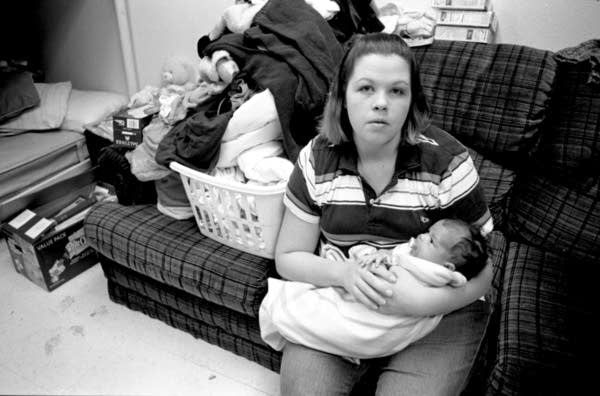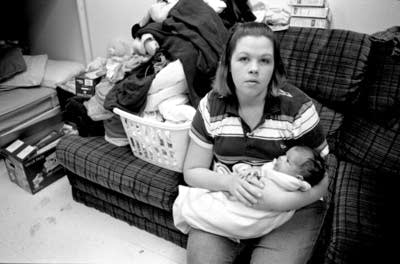Record increase in US poverty with elections looming

By Hope Yen and Liz Sidoti, Associated Press Writers
WASHINGTON (AP) - The number of people in the U.S. who are in poverty is on track for a record increase on President Barack Obama's watch, with the ranks of working-age poor approaching 1960s levels that led to the national war on poverty.
Census figures for 2009 - the recession-ravaged first year of the Democrat's presidency - are to be released in the coming week, and demographers expect grim findings.
It's unfortunate timing for Obama and his party just seven weeks before important elections when control of Congress is at stake. The anticipated poverty rate increase - from 13.2 percent to about 15 percent - would be another blow to Democrats struggling to persuade voters to keep them in power.
Create a More Connected Minnesota
MPR News is your trusted resource for the news you need. With your support, MPR News brings accessible, courageous journalism and authentic conversation to everyone - free of paywalls and barriers. Your gift makes a difference.
"The most important anti-poverty effort is growing the economy and making sure there are enough jobs out there," Obama said Friday at a White House news conference.
He stressed his commitment to helping the poor achieve middle-class status and said, "If we can grow the economy faster and create more jobs, then everybody is swept up into that virtuous cycle."
Interviews with six demographers who closely track poverty trends found wide consensus that 2009 figures are likely to show a significant rate increase to the range of 14.7 percent to 15 percent.

Should those estimates hold true, some 45 million people in this country, or more than 1 in 7, were poor last year. It would be the highest single-year increase since the government began calculating poverty figures in 1959. The previous high was in 1980 when the rate jumped 1.3 percentage points to 13 percent during the energy crisis.
Among the 18-64 working-age population, the demographers expect a rise beyond 12.4 percent, up from 11.7 percent. That would make it the highest since at least 1965, when another Democratic president, Lyndon B. Johnson, launched the war on poverty that expanded the federal government's role in social welfare programs from education to health care.
Demographers also are confident the report will show:
-Child poverty increased from 19 percent to more than 20 percent.
-Blacks and Latinos were disproportionately hit, based on their higher rates of unemployment.
-Metropolitan areas that posted the largest gains in poverty included Modesto, Calif.; Detroit; Cape Coral-Fort Myers, Fla.; Los Angeles and Las Vegas.
"My guess is that politically these figures will be greeted with alarm and dismay but they won't constitute a clarion call to action," said William Galston, a domestic policy aide for President Bill Clinton. "I hope the parties don't blame each other for the desperate circumstances of desperate people. That would be wrong in my opinion. But that's not to say it won't happen."
Lawrence M. Mead, a New York University political science professor who is a conservative and wrote "The New Politics of Poverty: The Nonworking Poor in America," argued that the figures will have a minimal impact in November.
"I hope the parties don't blame each other for the desperate circumstances of desperate people. That would be wrong."
"Poverty is not as big an issue right now as middle-class unemployment. That's a lot more salient politically right now," he said.
But if Thursday's report is as troubling as expected, Republicans in the midst of an increasingly strong drive to win control of the House, if not the Senate, would get one more argument to make against Democrats in the campaign homestretch.
The GOP says voters should fire Democrats because Obama's economic fixes are hindering the sluggish economic recovery. Rightly or wrongly, Republicans could cite a higher poverty rate as evidence.
Democrats almost certainly will argue that they shouldn't be blamed. They're likely to counter that the economic woes - and the poverty increase - began under President George W. Bush with the near-collapse of the financial industry in late 2008.
Although that's true, it's far from certain that the Democratic explanation will sway voters who already are trending heavily toward the GOP in polls as worrisome economic news piles up.
Hispanics and blacks - traditionally solid Democratic constituencies - could be inclined to stay home in November if, as expected, the Census Bureau reports that many more of them were poor last year.
Beyond this fall, the findings could put pressure on Obama to expand government safety net programs ahead of his likely 2012 re-election bid even as Republicans criticize him about federal spending and annual deficits. Those are areas of concern for independent voters whose support is critical in elections.
Experts say a jump in the poverty rate could mean that the liberal viewpoint - social constraints prevent the poor from working - will gain steam over the conservative position that the poor have opportunities to work but choose not to because they get too much help.
"The Great Recession will surely push the poverty rate for working-age people to a nearly 50-year peak," said Elise Gould, an economist with the Economic Policy Institute. She said that means "it's time for a renewed attack on poverty."
To Douglas Besharov, a University of Maryland public policy professor, the big question is whether there's anything more to do to help these families.
The 2009 forecasts are largely based on historical data and the unemployment rate, which climbed to 10.1 percent last October to post a record one-year gain.
The projections partly rely on a methodology by Rebecca Blank, a former poverty expert who now oversees the census. She estimated last year that poverty would hit about 14.8 percent if unemployment reached 10 percent.
"As long as unemployment is higher, poverty will be higher," she said in an interview then.
A formula by Richard Bavier, a former analyst with the White House Office of Management and Budget who has had high rates of accuracy over the last decade, predicts poverty will reach 15 percent.
That would put the rate at the highest level since 1993. The all-time high was 22.4 percent in 1959, the first year the government began tracking poverty. It dropped to a low of 11.1 percent in 1973 after Johnson's war on poverty but has since fluctuated in the 12-14 percent range.
In 2008, the poverty level stood at $22,025 for a family of four, based on an official government calculation that includes only cash income before tax deductions. It excludes capital gains or accumulated wealth. It does not factor in noncash government aid such as tax credits or food stamps, which have surged to record levels in recent years under the federal stimulus program.
Beginning next year, the government plans to publish new, supplemental poverty figures that are expected to show even higher numbers of people in poverty than previously known. The figures will take into account rising costs of medical care, transportation and child care, a change analysts believe will add to the ranks of both seniors and working-age people in poverty.
(Copyright 2010 by The Associated Press. All Rights Reserved.)
